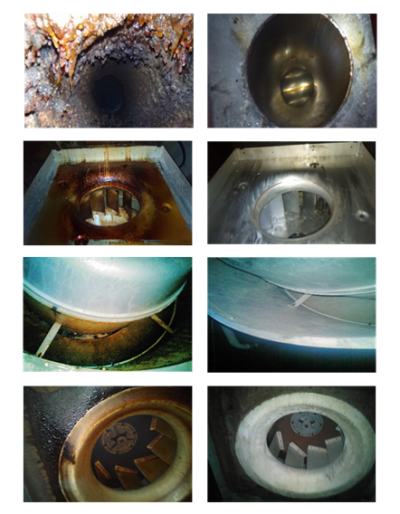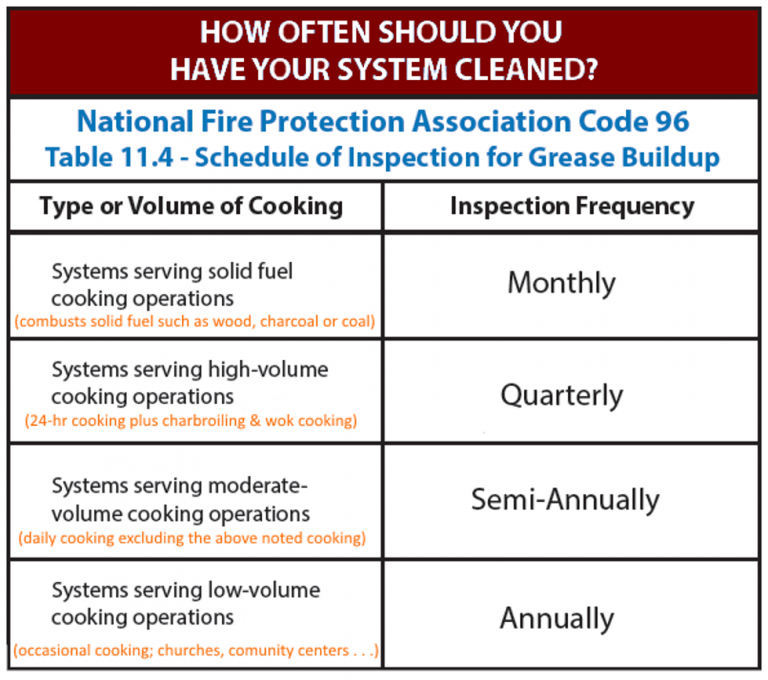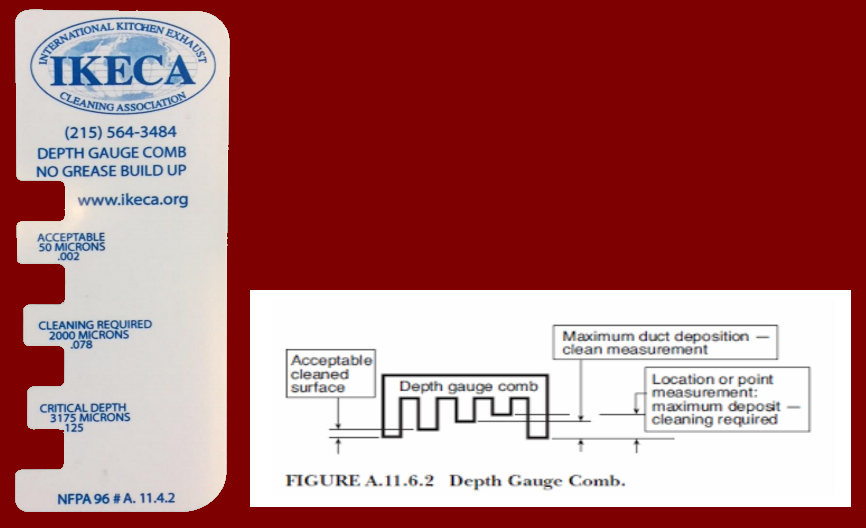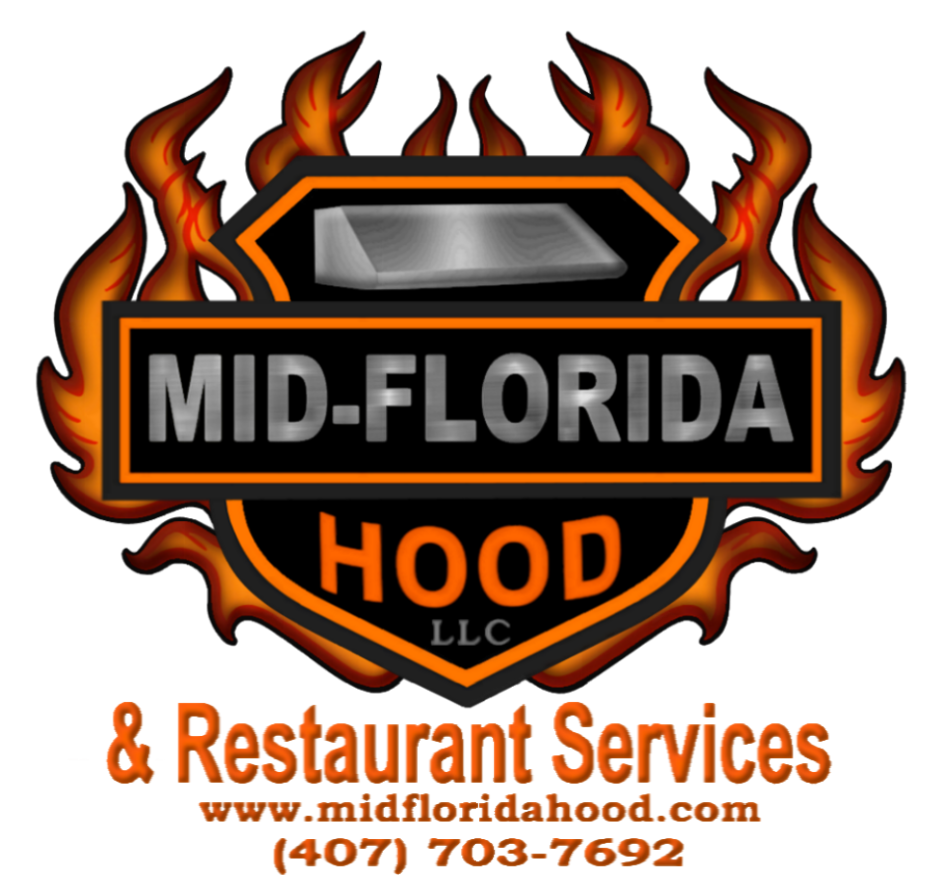FAQ

have questions ?
.
As a guideline for the minimum cleaning frequencies you can reference NFPA 96 Table 11.4.
Many things may influence how often your exhaust system should be cleaned including how much you are cooking, what you are cooking, equipment set-up, exhaust system design, building design and insurance requirements.
The average job takes between 3-8hrs depending on the number of systems & amount of ductwork to be cleaned.
Our prices start at $425 for jobs that take up to three hours ($500 for high temp/flame/wok style cooking). If travel is over 1hr (30min each way), that time is included as part of the job’s cleaning time.
We assign a flat rate that is basically equivalent to $120/hr ($150/hr for high temp/flame/wok style cooking) plus $75 for cleaning supplies. This rate covers supplies & labor with up to 3techs. Our flat rates are only valid for services that are cleaned as recommended and not overdue (15+days for Quarterly & 30+days for Semi Annually). Overdue services may incur additional labor fees to cover the additional supplies and labor required to complete the service.
All hood cleaners do not provide the same level of service. It takes time to clean an exhaust system properly! We clean your roof top fans, all the grease ducts from the roof to the canopy hood, the grease baffle filters and the canopy hood. Some systems have a limited amount of ductwork to be cleaned while others have vertical & horizontal ducts with several bends in them.
We clean the entire system down to bare metal as stated in the fire code. 11.6.1.1.1 . . . shall be cleaned to remove combustible contaminants to a minimum of 50 microns (0.002 in.) *see grease depth gauge below
Be wary of companies that offer cheap rates. The only way they can afford to do this is to keep labor hours low. The way this is done is to only clean what’s visable. This completely defeats the reason you’re having the exhaust system cleaned.
Yes. The service sticker certifies that your equipment was cleaned by a company that adheres to NFPA Code 96 standards. It includes our company name, lead service tech’s name, date of service, and date the sticker expires (next service date due).
We also offer service reports and before/after pictures if requested.
No. You may stay and watch if you want but it is not required. Customers who do stay are often surprised at how much work is involved with the job. We welcome you to stay and watch because of this.
Feel assured that your restaurant is safe. We carry 1mil liability insurance plus a safety bond.
We clean when your kitchen is not in use.
We work Sunday thru Thursday with Friday & Saturday off. Most jobs are performed in the evening or overnight hours with the occasional job being done during the day. Early day time jobs are more difficult for us to schedule since our techs are used to getting home between 4-7am & usually sleep until the afternoon.
Please refer to these documents from the Florida Deptpartment of Revenue for clarification.
Technical Assistance Advisement 14A-020 on taxability of hood cleaning & repair services. https://www.floridasalestax.com/documents/TAA-14A-020.pdf
Sales and Use Tax on Cleaning Services. http://floridarevenue.com/Forms_library/current/gt800015.pdf
Sales and Use Tax on Construction, Improvements,Installations and Repairs. http://floridarevenue.com/forms_library/current/gt800067.pdf
We invoice our repairs & service calls using the time-and-material type contract to keep things simple. Our company pays sales tax on all supplies and parts we purchase, then include them under materials used.
NFPA 96: Standard for Ventilation Control and Fire Protection of Commercial Cooking Operations
Summaries & Videos sourced from Hood Filters.com Text from NFPA 96 2017 Edition
What is NFPA 96?
Summary: The National Fire Protection Association (NFPA) standards are what local and state fire and building inspectors follow as well as the insurance industry.
NFPA 96 is a set of codes and standards for ventilation control and fire protection of commercial cooking operations by the National Fire Protection Association.
These are the standards that fire marshals follow and commercial cooking operations are required to adhere to.
1.1.1 Scope. The minimum fire safety requirements (preventative and operative) related to the design, installation, operation, inspection, and maintenance of all public and private cooking operations.
1.2 Purpose. The purpose of this standard shall be to reduce the potential fire hazard of cooking operations, irrespective of the type of cooking equipment used and whether it is used in public or private facilities.
1.3.2 Application. The authority having jurisdiction shall determine compliance with this standard and authorize equivalent deviations from all applications.
4.1.5 Responsibility. The responsibility for inspection, maintenance, and cleanliness of the ventilation control and fire protection of the commercial cooking operations shall ultimately be that of the owner of the system, provided that this responsibility has not been transferred in written form to a management company, tenant, or other party.
NFPA 96 Fire Codes for Inspection & Cleaning of Kitchen Exhaust Systems
Text from NFPA 96 2017 Edition
Summary: You are required to have your exhaust system cleaned at the frequency shown below. If you have questions about which category your facility is in, contact your local fire inspector. *Table 11.4 Schedule of Inspection for Grease Buildup
11.6.1 – Upon inspection, if the exhaust system is found to be contaminated with deposits from grease-laden vapors, the contaminated portions of the exhaust system shall be cleaned by a properly trained, qualified, and certified company or person(s) acceptable to the authority having jurisdiction.
11.6.1.1.1- Hoods, grease removal devices, fans, ducts, and other appurtenances shall be cleaned to removed combustible contaminants to a minimum of 50 microns (0.002 in.).
11.6.1.1.2 – A grease depth gauge comb as shown in Figure 11.6.1.1.2 shall be placed upon the surface to measure grease depth.
11.6.2 – Hoods, grease removal devices, fans, ducts, and other appurtenances shall be cleaned to remove combustible contaminants prior to surfaces becoming heavily contaminated with grease or oily sludge.
NFPA 96 Fire Codes for Duct Access & Access Panels
Click Here to search Grease Duct Access Doors from Hood Filters.com
Summary: Grease Duct Access Doors are required to be installed on every 12’ of grease duct.
Video: Duct Access Door Comparison
Text from NFPA 96 2017 Edition
4.1.8 – All interior surfaces of the exhaust system shall be accessible for cleaning and inspection purposes
5.1.2 – All seems, joints, and penetrations of the hood enclosure that direct and capture grease-laden vapors and exhaust gases shall have a liquid tight continuous external weld to the hood’s lower outermost perimeter
7.3.1 – Openings shall be provided at the sides or at the top of the duct, whichever is more accessible, and at a change of direction
7.4.1.1 – On horizontal ducts, at least one 508 mm x 508 mm (20 in. x 20 in.) opening shall be provided for personnel entry
7.4.1.2 – Where an opening of this size is not possible, openings large enough to permit thorough cleaning shall be provided at 3.7 m (12 ft) intervals
7.4.1.3 – If not easily accessible from a 3 m (10 ft) stepladder, openings on horizontal grease duct systems shall be provided with safe access and a work platform
7.4.2.2 – Where personnel entry is not possible, adequate access for cleaning shall be provided on each floor
7.5.2.1 – all seams, joints, penetrations, and duct-to-hood collar connections shall have a liquid tight continuous external weld.
NFPA 96 Fire Codes for Fan Access Panel
Click Here to Search our Exhaust Fan Access Panel
Summary: Exhaust fans must have an access panel installed so the fan blades can be inspected and cleaned.
Video: Exhaust Fan Access Panel
Text From NFPA 96 2017 Edition
8.1.5.3.1- Upblast fans shall be supplied with an access opening of a minimum 76 mm by 127 mm (3 in. by 5 in.) or a circular diameter of 101 mm (4 in.) on the curvature of the outer fan housing to allow for cleaning and inspection of the fan blades
8.1.5.3.2 – On existing upblast fans where sufficient access is not available to allow for the removal of grease contamination, an approved hinge mechanism or access panel shall be installed
NFPA 96 Fire Codes for Hood Grease Filters
Summary: Commercial kitchens are required to use hood filters that are UL listed. When shopping for filters the description should clearly state if they are. Beware of any filters that do not mention it. If they are that means they are Fire Code approved and meet your insurance requirements.
To determine if your existing filters are Fire Code approved you can look on the edge of the filters for a UL or ETL logo stamped into the frame. If there is no UL or ETL stamp they need to be replaced.
Video: Why You Should Choose a UL Listed Baffle Grease Hood Filter
6.1 Grease Removal Devices
6.1.1 – Listed grease filters, listed baffles, or other listed grease removal devices for use with commercial cooking equipment shall be provided
6.1.2 – Listed grease filters and grease removal devices that are removable but not an integral component of a specific listed exhaust hood shall be listed in accordance with UL 1046
6.1.3 – Mesh filters shall not be used unless evaluated as an integral part of a listed exhaust hood or listed in conjunction with a primary filter in accordance with UL 1046
6.2.3.1 – Grease filters shall be listed and constructed of steel or listed equivalent material.
6.2.3.2 – Grease filters shall be of rigid construction that will not distort or crush under normal operation, handling, and cleaning conditions
6.2.3.3 – Grease filters shall be arranged so that all exhaust air passes through the grease filters.
6.2.3.4 – Grease filters shall be easily accessible and removable for cleaning.
6.2.3.5 – Grease filters shall be installed at an angle not less than 45 degrees from the horizontal
NFPA 96 Fire Codes for Solid Fuel Cooking Systems & Spark Arrestor Filters
Click Here to Search our Spark Arrestor Hood Filters
Summary: If you are cooking with solid fuel such as wood or charcoal you are required to use Spark Arrestor hood filters. Spark Arrestor Hood Filters are easy to identify as they have a diamond pattern grate on the front.
Video: Do I Need Spark Arrestor Hood Filters For Solid Fuel Cooking?
Text From NFPA 96 2017 Edition
14.5.1 – Grease removal devices shall be constructed of steel or stainless steel or be approved for solid fuel cooking
14.5.2 – If airborne sparks and embers can be generated by the solid fuel cooking operation, spark arrestor devices shall be used prior to using the grease removal device to minimize the entrance of the sparks and embers into the grease removal device and into the hood and duct system.
14.5.3 – Filters shall be a minimum of 1.2 m (4 ft) above the appliance cooking surface
NFPA 96 Fire Codes for Fan Hinges
Click Here to Search our Fan Hinges
Summary: Exhaust fans must have a hinge with a “hold open” retainer installed on them.
Video: What You Need to Know About Exhaust Fan Hinge Kits
Text From NFPA 96 2017 Edition
7.8.2.1 Rooftop termination shall be arranged with or provided with the following:
(8) A hinged upblast fan supplied with flexible weatherproof electrical cable and service hold-open retainer to permit inspection and cleaning that is listed for commercial cooking equipment…
8.1 Exhaust Fans for Commercial Cooking Equipment
8.1.1.1 – Approved upblast fans with motors surrounded by the airstream shall be hinged, supplied with flexible weatherproof electrical cable and service hold-open retainers, and listed for this use
9.2.1 – Wiring systems of any type shall not be installed in ducts
NFPA 96 Fire Codes for Rooftop Grease Containment
Click Here to Search our Grease Containment Systems
Summary: Exhaust fans are required to have grease containment system installed on them.
Video: What You Should Know About Rooftop Grease Containment
Text From NFPA 96 2017 Edition
7.8.2 Rooftop Terminations
7.8.2.1 Rooftop termination shall be arranged with or provided with the following:
(4) The ability to drain grease out of any traps or low points formed in the fan or duct near the termination of the system into a collection container that is noncombustible, closed, rainproof, and structurally sound for the service to which it is applied and that will not sustain combustion
(5) A grease collection device that is applied to exhaust systems that does not inhibit the performance of any fan
[6] Listed grease collection systems that meet the requirements of 7.8.2.1(4) and 7.8.2.1(5)
8.1 Exhaust Fans for Commercial Cooking Equipment
8.1.1.3 Upblast fans shall have a drain directed to a readily accessible and visible grease receptacle not to exceed 3.8 L (1 gal).



We'd be glad to answer any questions you have.
...
Reach Us
Location :
Apopka, Fl
Email :
office@midfloridahood.com
Phone :
407-703-7692
